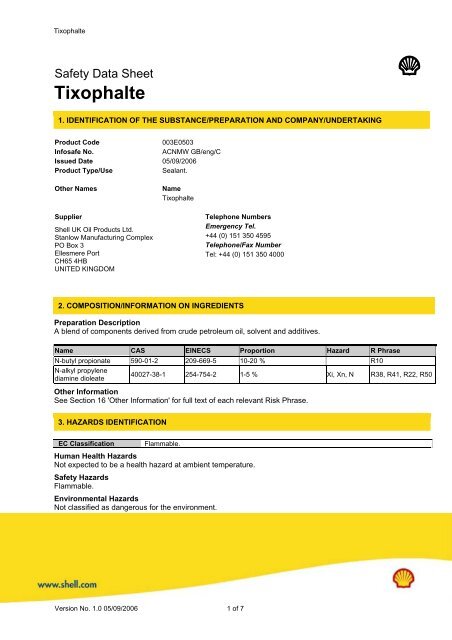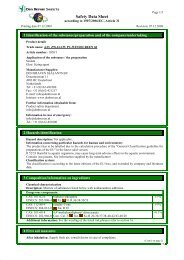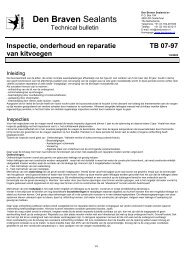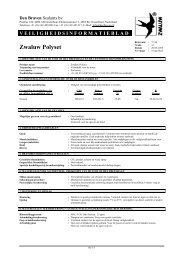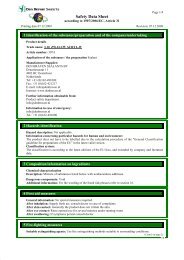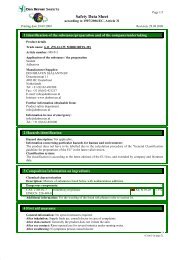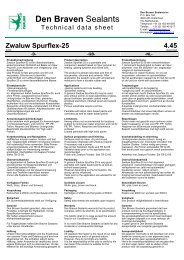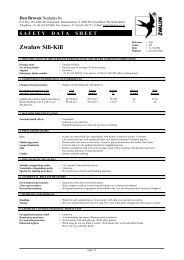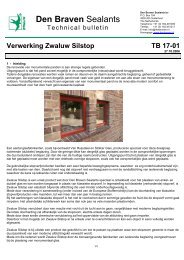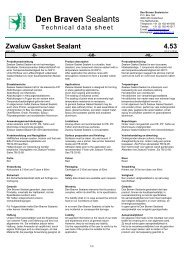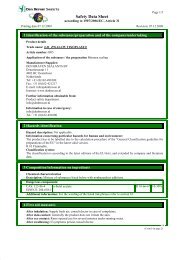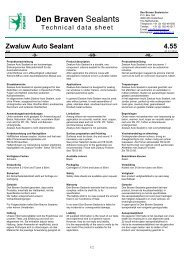Tixophalte - Den Braven
Tixophalte - Den Braven
Tixophalte - Den Braven
You also want an ePaper? Increase the reach of your titles
YUMPU automatically turns print PDFs into web optimized ePapers that Google loves.
<strong>Tixophalte</strong><br />
Safety Data Sheet<br />
<strong>Tixophalte</strong><br />
1. IDENTIFICATION OF THE SUBSTANCE/PREPARATION AND COMPANY/UNDERTAKING<br />
Product Code 003E0503<br />
Infosafe No. ACNMW GB/eng/C<br />
Issued Date 05/09/2006<br />
Product Type/Use Sealant.<br />
Other Names Name<br />
<strong>Tixophalte</strong><br />
Supplier Telephone Numbers<br />
Shell UK Oil Products Ltd.<br />
Stanlow Manufacturing Complex<br />
PO Box 3<br />
Ellesmere Port<br />
CH65 4HB<br />
UNITED KINGDOM<br />
2. COMPOSITION/INFORMATION ON INGREDIENTS<br />
Version No. 1.0 05/09/2006 1 of 7<br />
Emergency Tel.<br />
+44 (0) 151 350 4595<br />
Telephone/Fax Number<br />
Tel: +44 (0) 151 350 4000<br />
Preparation Description<br />
A blend of components derived from crude petroleum oil, solvent and additives.<br />
Name CAS EINECS Proportion Hazard R Phrase<br />
N-butyl propionate 590-01-2 209-669-5 10-20 % R10<br />
N-alkyl propylene<br />
diamine dioleate<br />
40027-38-1 254-754-2 1-5 % Xi, Xn, N R38, R41, R22, R50<br />
Other Information<br />
See Section 16 'Other Information' for full text of each relevant Risk Phrase.<br />
3. HAZARDS IDENTIFICATION<br />
EC Classification Flammable.<br />
Human Health Hazards<br />
Not expected to be a health hazard at ambient temperature.<br />
Safety Hazards<br />
Flammable.<br />
Environmental Hazards<br />
Not classified as dangerous for the environment.
<strong>Tixophalte</strong><br />
4. FIRST AID MEASURES<br />
Symptoms and Effects<br />
Not expected to give rise to an acute hazard under normal conditions of use.<br />
Inhalation<br />
If inhalation of mists, fumes or vapour causes irritation to the nose or throat, remove to fresh air. If rapid<br />
recovery does not occur, obtain medical attention.<br />
Skin<br />
Remove contaminated clothing. Flush exposed area with water and follow by washing with soap if available. If<br />
persistent irritation occurs, obtain medical attention.<br />
Eye<br />
Flush eye with copious quantities of water. If persistent irritation occurs, obtain medical attention.<br />
Ingestion<br />
Under normal conditions of use this is not expected to be a primary route of exposure.<br />
Advice to Doctor<br />
Treat symptomatically.<br />
5. FIRE FIGHTING MEASURES<br />
Specific Hazards<br />
Combustion is likely to give rise to a complex mixture of airborne solid and liquid particulates and gases,<br />
including carbon monoxide and unidentified organic and inorganic compounds.<br />
Extinguishing Media<br />
Foam, water spray or fog. Dry chemical powder, carbon dioxide, sand or earth may be used for small fires only.<br />
Unsuitable Extinguishing Media<br />
Do not use water in a jet.<br />
Protective Equipment<br />
Proper protective equipment including breathing apparatus must be worn when approaching a fire in a confined<br />
space.<br />
6. ACCIDENTAL RELEASE MEASURES<br />
Personal Precautions<br />
Avoid contact with skin, eyes, clothing. Do not breathe fumes, vapour. Remove all possible sources of ignition in<br />
the surrounding area. Use compressed air or fresh air respiratory equipment in confined spaces.<br />
Environmental Precautions<br />
Prevent from spreading or entering into drains, ditches or rivers by using sand, earth, or other appropriate<br />
barriers.<br />
Clean-up Methods - Small Spillages<br />
Shovel into a suitable, clearly marked container for disposal or reclamation in accordance with local regulations.<br />
Clean-up Methods - Large Spillages<br />
Prevent from spreading by making a barrier with sand, earth or other containment material. Treat residues as<br />
for small spillage.<br />
Other Information<br />
Local authorities should be advised if significant spillages cannot be contained.<br />
Version No. 1.0 05/09/2006 Page 2 of 7
<strong>Tixophalte</strong><br />
7. HANDLING AND STORAGE<br />
Handling<br />
Avoid contact with skin, eyes, and clothing. Extinguish any naked flames. Remove ignition sources. Avoid<br />
sparks. Do not smoke.<br />
For quality, health and safety reasons do not exceed the recommended storage and handling temperature. Only<br />
use in well-ventilated areas. When handling product in drums, safety footwear should be worn and proper<br />
handling equipment should be used. Exposure to this product should be reduced as low as reasonably<br />
practicable. Reference should be made to the Health and Safety Executive's publication 'COSHH Essentials'.<br />
Storage<br />
Keep container tightly closed and in a cool, well-ventilated place. Use properly labelled and closeable<br />
containers. Protect from frost.<br />
Storage Temperatures<br />
5ºC Minimum. 30ºC Maximum.<br />
Recommended Materials<br />
For containers or container linings, use mild steel, stainless steel or aluminium.<br />
Unsuitable Materials<br />
For containers or container linings avoid PVC, polyethylene or high density polyethylene.<br />
8. EXPOSURE CONTROLS, PERSONAL PROTECTION<br />
Exposure Limits<br />
Substance Regulations Exposure Duration Exposure Limit Units Notes<br />
Asphalt (petroleum;<br />
bitumen) fume, as<br />
benzene-soluble<br />
aerosol, inhalable<br />
particulate<br />
EH 40 2005 TWA 5 mg/m3<br />
EH 40 2005 STEL 10 mg/m3<br />
EH 40 2005 EH 40 2005 Health and Safety Executive. EH40; Workplace Exposure Limits<br />
Exposure Controls<br />
The level of protection and types of controls necessary will vary depending upon potential exposure conditions.<br />
Select controls based on a risk assessment of local circumstances. Appropriate measures include: Adequate<br />
ventilation to control airborne concentrations below the exposure guidelines/limits.<br />
Hygiene Measures<br />
Wash hands before eating, drinking, smoking and using the toilet.<br />
Respiratory Protection<br />
In the event of an inhalation risk, use with local exhaust ventilation.<br />
Hand Protection<br />
PVC, neoprene, or nitrile rubber gloves. Chemical protective gloves are made from a wide range of materials, but<br />
there is no single glove material ( or combination of materials) which gives unlimited resistance to any individual<br />
or combination of substances or preparations. The extent of the breakthrough time will be affected by a<br />
combination of factors which include permeation, penetration, degradation, use pattern ( full immersion,<br />
occasional contacts) and how the glove is stored when not in use.<br />
Theoretical maximum levels of protection are seldom achieved in practice and the actual level of protection can<br />
be difficult to assess.<br />
Version No. 1.0 05/09/2006 3 of 7
<strong>Tixophalte</strong><br />
Eye Protection<br />
Wear safety glasses or full face shield if splashes are likely to occur.<br />
Body Protection<br />
Standard issue work clothes. Safety shoes or boots - chemical resistant.<br />
Personal Protective Equipment<br />
Personal protective equipment (PPE) should meet recommended national standards. Check with PPE suppliers.<br />
Environmental Exposure Controls<br />
Minimise release to the environment. An environmental assessment must be made to ensure compliance with<br />
local environmental legislation.<br />
9. PHYSICAL AND CHEMICAL PROPERTIES<br />
Colour Black.<br />
Physical State Semi-solid at ambient temperature.<br />
Odour Characteristic.<br />
Solubility in Water Negligible.<br />
<strong>Den</strong>sity 1300 kg/m3 at 20ºC.<br />
Flash Point >37ºC.<br />
10. STABILITY AND REACTIVITY<br />
Stability<br />
Stable under normal use conditions.<br />
Conditions to Avoid<br />
Heat, flames and sparks.<br />
Materials to Avoid<br />
Strong oxidizing agents.<br />
Hazardous Decomposition Products<br />
Hazardous decomposition products are not expected to form during normal storage.<br />
11. TOXICOLOGICAL INFORMATION<br />
Basis for Assessment<br />
Toxicological data have not been determined specifically for this product. Information given is based on data on<br />
the components and the toxicology of similar products.<br />
Acute Toxicity - Oral<br />
LD50 > 2000 mg/kg.<br />
Acute Toxicity - Dermal<br />
LD50 > 2000 mg/kg.<br />
Acute Toxicity - Inhalation<br />
Not considered to be an inhalation hazard under normal conditions of use.<br />
Eye Irritation<br />
Expected to be slightly irritating.<br />
Skin Irritation<br />
Expected to be slightly irritating.<br />
Version No. 1.0 05/09/2006 Page 4 of 7
<strong>Tixophalte</strong><br />
Respiratory Irritation<br />
Inhalation of vapour or mists may cause irritation.<br />
Skin Sensitisation<br />
Not expected to be a skin sensitizer.<br />
Carcinogenicity<br />
Bitumen is not classified as dangerous under EC criteria, but it does contain low concentrations of Polycyclic<br />
Aromatic Compounds (PAC's). Undiluted these PAC’s are not considered to be bio-available. However, if<br />
bitumen is mixed with diluents to obtain a low viscosity at ambient temperatures it is believed that such<br />
materials may become bio-available. Despite the known presence of PAC's there is no evidence that exposure<br />
to undiluted bitumen or its' fumes is harmful.<br />
Mutagenicity<br />
Not considered to be a mutagenic hazard.<br />
Reproductive Toxicity<br />
Data not available.<br />
12. ECOLOGICAL INFORMATION<br />
Basis for Assessment<br />
Ecotoxicological data have not been determined specifically for this product. Information given is based on a<br />
knowledge of the components and the ecotoxicology of similar products.<br />
Mobility<br />
If it enters soil, it will adsorb to soil particles and will not be mobile. Sinks in water.<br />
Persistence / Degradability<br />
Not readily biodegradable.<br />
Bioaccumulation<br />
Has the potential to bioaccumulate. In practice, the very low water solubilities and high molecular weights of<br />
these substances are such that their bioavailability to aquatic organisms is limited and therefore<br />
bioaccumulation is unlikely.<br />
Ecotoxicity<br />
Poorly soluble mixture. May cause physical fouling of aquatic organisms. Product is expected to be practically<br />
non-toxic to aquatic organisms, LL/EL50 >100 mg/l. (LL/EL50 expressed as the nominal amount of product<br />
required to prepare aqueous test extract).<br />
Other Adverse Effects<br />
Not expected to have ozone depletion potential, photochemical ozone creation potential or global warming<br />
potential.<br />
13. DISPOSAL CONSIDERATIONS<br />
Product Disposal<br />
Recover or recycle if possible. Dispose in accordance with prevailing regulations, preferably to a recognised<br />
collector or contractor. The competence of the collector or contractor should be established beforehand. Do not<br />
dispose into the environment, in drains or in water courses.<br />
Container Disposal<br />
Recycle or dispose of in accordance with the legislation in force with a recognised collector or contractor.<br />
Local Legislation<br />
Comply with any local recovery or waste disposal regulations.<br />
Version No. 1.0 05/09/2006 5 of 7
<strong>Tixophalte</strong><br />
14. TRANSPORT INFORMATION<br />
ADR/RID UN Number<br />
3295<br />
ADR/RID Class<br />
3<br />
ADR/RID Packing Group<br />
III<br />
ADR/RID Proper Shipping Name<br />
HYDROCARBONS, LIQUID, N.O.S. - (BUTYL PROPIONATE)<br />
IMDG UN Number<br />
3295<br />
IMDG Hazard Class<br />
3<br />
IMDG Packing Group<br />
III<br />
IMDG Proper Shipping Name<br />
HYDROCARBONS, LIQUID, N.O.S. - (BUTYL PROPIONATE)<br />
IATA UN Number<br />
3295<br />
IATA Hazard Class<br />
3<br />
IATA Packing Group<br />
III<br />
IATA Proper Shipping Name<br />
HYDROCARBONS, LIQUID, N.O.S. - (BUTYL PROPIONATE)<br />
15. REGULATORY INFORMATION<br />
EC Symbols None.<br />
EC Risk Phrase R10 Flammable.<br />
S16 Keep away from sources of ignition - No smoking.<br />
EC Safety Phrase<br />
S2 Keep out of reach of children.<br />
S46 If swallowed, seek medical advice immediately and show this container or label.<br />
EINECS All components listed or polymer exempt.<br />
TSCA (USA) All components in compliance.<br />
National Legislation<br />
Environmental Protection Act 1990 (as amended).<br />
Health and Safety at Work Act 1974<br />
Consumers Protection Act 1987<br />
Control of Pollution Act 1974<br />
Environmental Act 1995<br />
Factories Act 1961<br />
Carriage of Dangerous Goods by Road and Rail (Classification, Packaging and Labelling) Regulations<br />
Chemicals (Hazard Information and Packaging for Supply) Regulations 2002.<br />
Control of Substances Hazardous to Health Regulations 1994 (as amended).<br />
Version No. 1.0 05/09/2006 Page 6 of 7
<strong>Tixophalte</strong><br />
Road Traffic (Carriage of Dangerous Substances in Packages) Regulations<br />
Merchant Shipping (Dangerous Goods and Marine Pollutants) Regulations<br />
Road Traffic (Carriage of Dangerous Substances in Road Tankers in Tank Containers) Regulations<br />
Road Traffic (Training of Drivers of Vehicles Carrying Dangerous Goods) Regulations<br />
Reporting of Injuries, Diseases and Dangerous Occurences Regulations<br />
Health and Safety (First Aid) Regulations 1981<br />
Personal Protective Equipment (EC Directive) Regulations 1992<br />
Personal Protective Equipment at Work Regulations 1992.<br />
Packaging & Labelling<br />
Safety data sheet available for professional user on request.<br />
16. OTHER INFORMATION<br />
Revisions Highlighted<br />
Because of a new system the version number was reset.<br />
References<br />
CONCAWE product dossier 92/104 - Bitumen and bitumen derivatives<br />
CONCAWE report 01/54 - Environmental classification of petroleum substances - summary data and rationale<br />
CONCAWE report 01/53 - Classification and labelling of petroleum substances according to the EU dangerous<br />
substances directive (CONCAWE recommendations - July 2005)<br />
CONCAWE report 5/02 - Amended safety data sheet directive (2002/58/EC)<br />
CEN/TC 19/SC Bitumen and bituminous binders, terminology<br />
Energy Institute - Bitumen safety code<br />
Eurobitume - Guidelines on the classification of bitumens and bituminous preparations<br />
EAPA - Guide to the compilation of safety data sheets for bituminous mixtures<br />
Restrictions<br />
This product must not be used in applications other than recommended without first seeking the advice of the<br />
SHELL technical department.<br />
List of R Phrases in Section 2<br />
R10 Flammable.<br />
R22 Harmful if swallowed.<br />
R38 Irritating to skin.<br />
R41 Risk of serious damage to eyes.<br />
R50 Very toxic to aquatic organisms.<br />
Further Information<br />
This information is based on our current knowledge and is intended to describe the product for the purposes of<br />
health, safety and environmental requirements only. It does not constitute a guarantee for any specific property<br />
of the product.<br />
... End Of SDS ...<br />
Version No. 1.0 05/09/2006 7 of 7


